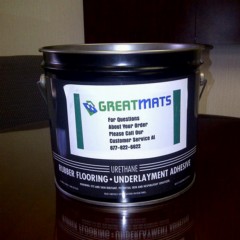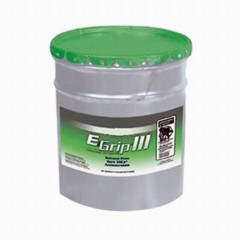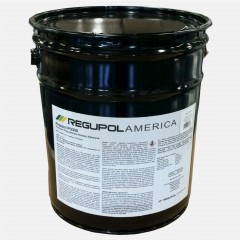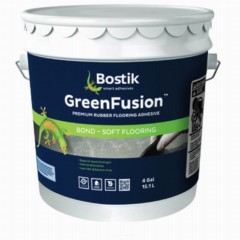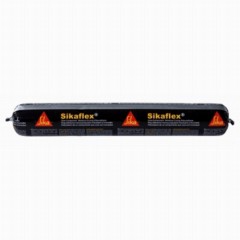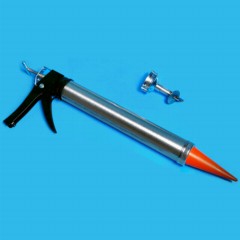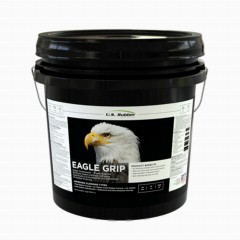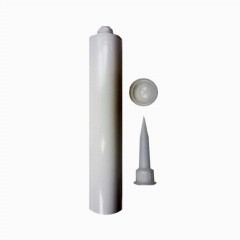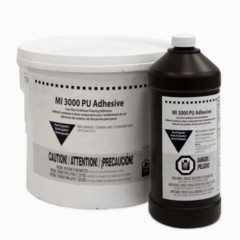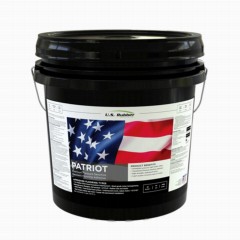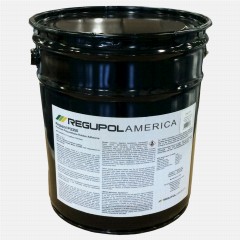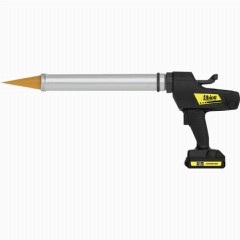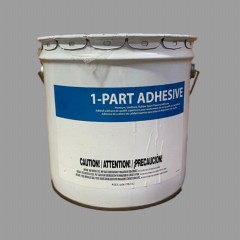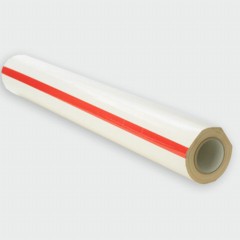Options for Rubber Flooring Adhesive
Choosing to install rubber floors provides several benefits. If you want to make it a permanent installation, you’ll need to use rubber flooring adhesive. At Greatmats, we carry a variety of rubber mat adhesive products to give you the most secure installation. If you need help matching the right adhesive to the rubber flooring product you’ve selected, our team is ready to advise you. Gluing rubber to concrete or wood subfloor surfaces doesn’t have to be a scary process when you rely on Greatmats. (The amount of adhesive that ends up on your clothing is up to you.)
Types of Glue for Rubber Gym Flooring
You can select either one-part or two-part formulas in our glue for rubber gym flooring products.
One-Part
Our one-part adhesives do not require any mixing. You can simply apply the adhesive straight from the container for a secure installation.
Two-Part
Our two-part rubber gym flooring adhesive requires mixing a resin and a hardener. Just follow the instructions with the adhesive to mix the two parts in the correct ratio.
Purchasing Tips for Adhesive for Rubber Flooring
Here are some tips to help you buy the proper adhesive for rubber flooring that fits your precise needs.
- If you’re applying the rubber floor adhesive to concrete, select a product made specifically for concrete.
- Always read through the installation instructions for your rubber rolls for recommendations on the type of adhesive to use.
- Apply the adhesive at the recommended thickness level. Using an application that’s too thick might push adhesive outside the borders of the tiles or mats.
- Some rubber mats manufacturers recommend specific brands of adhesive to use with their products, and you should follow those recommendations.
- Containers of adhesive are heavy and pricey to ship. To cut down on shipping costs, purchase the adhesive and the rubber matting from the same supplier. At Greatmats, we carry multiple options for rubber floors and adhesive to help with shipping costs.
- If you’re buying more than one container of adhesive for rubber pavers, ask about shipping options to try to save some money.
Installation Tips for Rubber Floor Glue
You can apply our adhesive products as a DIY project, or you can hire a professional. Some tips for applying rubber floor glue include:
- The adhesive is similar in consistency to caulk or grout.
- You may want to use a trowel to spread it across the subfloor.
- A notched trowel will provide the best adhesion.
- If your adhesive ships in a tube instead of a bucket, you can squeeze it by hand or use a caulk gun, depending on the tube’s design.
- Common subfloor materials that our adhesives work with include cured concrete, primed concrete, and plywood.
- Our adhesives work best when applied at a room temperature of at least 60 degrees Fahrenheit.
- Allow the bucket or tube of adhesive to adjust to the temperature of the room gradually by placing it in the room 24 hours before installation.
- Clean any overflowed or spilled adhesive while it’s still wet. It is difficult to remove after it hardens. Mineral spirits can help with cleanup.
Rubber Flooring Adhesive Q&A
Should I use glue or rubber flooring adhesive?
Choosing to
use glue or rubber flooring adhesive on your rubber floor depends on the instructions from the flooring manufacturer. For a permanent installation, you need to secure the rubber floor to the subfloor. Many rubber flooring products will require a rubber flooring adhesive, rather than any random type of glue. We carry many different models of this adhesive at Greatmats to match your floor design.
What are the best rubber flooring adhesive products?
The
best adhesive for rubber flooring to use with your rubber floors will depend on the type of rubber floor you’re installing and the subfloor material. Many rubber floors need a urethane-based adhesive, while others require polyurethane (PU) adhesive. At Greatmats, we carry a variety of rubber floor adhesive products, so you can find and use the perfect one.
How do you apply glue for rubber tiles?
To apply glue for rubber flooring and tiles, start by cleaning the subfloor and allowing it to dry. Do a dry lay of the rubber tiles, cutting any pieces to fit as necessary. Once you know how the layout will go, you can begin gluing the pieces to the subfloor. Follow the instructions on the rubber flooring glue and from the tile manufacturer to ensure a secure installation. With most rubber tiles, you must apply pressure over the final layout to ensure the tiles fully adhere to the subfloor.
5 reviews
$14694 /Each You Save 19%$27.99/sqftShips Out in 11-14 Working DaysShop$31376 /Each You Save 20%Ships Out in 1-3 Working Days SustainableShop$36593 /Each You Save 17%Ships Out in 1-3 Working DaysShop$1722 /Each You Save 18%Ships Out in 4-6 Working DaysShop$25900 /Each You Save 20%Ships Out in 5-7 Working DaysShop $16023 /Each You Save 15%$1.07/sqftShips Out in 4-6 Working Days SustainableShop$17316 /Each You Save 20%Ships Out in 5-7 Working DaysShop$16411 /Each You Save 20%Ships Out in 1-3 Working Days SustainableShop$25350 /Roll You Save 15%$0.95/sqftShips Out in 4-6 Working DaysShop
$16023 /Each You Save 15%$1.07/sqftShips Out in 4-6 Working Days SustainableShop$17316 /Each You Save 20%Ships Out in 5-7 Working DaysShop$16411 /Each You Save 20%Ships Out in 1-3 Working Days SustainableShop$25350 /Roll You Save 15%$0.95/sqftShips Out in 4-6 Working DaysShop